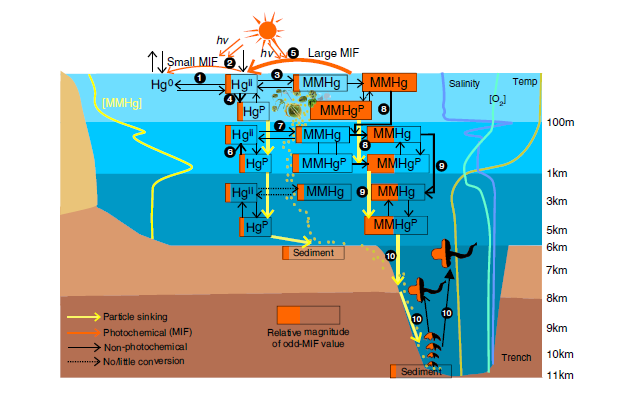Mercury (Hg) is a toxic and volatile element, which can be transported globally. Since the Industrial Revolution, atmospheric Hg concentrations have increased by 3-5 times due to human activities, resulting in elevated Hg burden in surface ecosystems. Hg entered into the ocean can transform to highly toxic mono-methylmercury (MMHg) by anaerobic bacteria, which tends to bioaccumulate and magnify along the marine food webs, posing great threats to high trophic fishes, mammals and humans.In the context of global change, research on the production, transformation and bioaccumulation of marine MMHg is of great significance for the formulation of global and regional environmental policies (e.g. Minamata Convention on Mercury).
At present, net MMHg production is thought to occur in situ in the oxygen-depleted zone of mesopelagic waters of the ocean (100-1000 m). Although MMHg is also demonstrated to produce in the epigenetic waters (0-100 m), the rapid photo-degradation of MMHg commonly results into a depletion of MMHg in surface oceans. Recently, with the increasing coverage of cruise-based Hg data, more and more studies have shown rather high MMHg concentrations in deep marine waters (>1000 m). The ensuing question is where the deep-sea MMHg comes from? In order to find the answer, Dr. Ruoyu Sun from SESS cooperated with researchers from the Institute of Deep Sea Science and Engineering, CAS, Laboratoire Géosciences Environnement Toulouse, CNRS, Nankai University and Nanjing University. They used patented submersibles and landers produced in China to conduct deep-sea exploration and sampling (Fig. 1), and revealed the source and transport pathways of deep-sea MMHg using Hg isotopes of the Mariana/Yap Trench fauna.
Ruoyu Sun et al. found that the trench fauna at 7000–11000 m depth all had substantially positive mass-independent fractionation of odd Hg isotopes (odd-MIF), which is similar to fishes at 0-1000 m depth. In addition, the surface sediments from the Mariana Trench had very small positive odd-MIF, which is similar to suspended particulate matter in the upper ocean. Although MMHg concentrations in trench fauna vary greatly, their Hg isotope compositions exhibit no significant change, indicating that inorganic Hg and MMHg in fauna have similar isotope compositions (i.e. significant odd-MIF). Considering the deep-water formation mechanism, MMHg life time, and particulate transport pathways, the researchers conclude that trench fauna MMHg mainly comes from the upper ocean where the photodegraded MMHg of the surface ocean is mixed with the non-photodegraded MMHg of the intermediate ocean. The MMHg in upper oceans likely transports down to deep-sea food chains through attachment to sinking particulate matters (Fig. 2). Although the deep ocean occupies more than 70% of the whole Ocean’s volume, there is little in-situ MMHg production. Besides, the researchers also extend this study to dimethyl-Hg production in oceans and in-vivo detoxification of MMHg.
One previous study published on Nature (Lamborg et al., 2014) calculated that there were >60,000 tons of anthropogenic Hg in oceans, 2/3 of which was confined in upper oceans, and the rest was relocated in the rapid deep-water formation areas (North Atlantic Deep Water and Antarctic BottomWater). However, Ruoyu Sun et al. found that the anthropogenic Hg released at the Earth’s surface is much more pervasive across deep oceans than was previously thought. Ongoing surface ocean warming that possibly increases MMHg levels in the upper oceans (Schartup et al., 2019) would likely rapidly propagate to the hadal ecosystems.
This research was recently published on Nature Communications with a title of Methylmercury produced in upper oceans accumulates in deep Mariana Trench fauna, and was funded by National Key Research and Development Plan (2016YFC0300503; 2017YFC0212700), National Natural Science Foundation of China (41625012; 41602345; 41922019; U1612442; 41961144028) and Natural Science Foundation of Tianjin (17JCYBJC23500). This study has been highlighted on Goldschmidt Conference during 21-26 June, 2020 [http://earth.tju.edu.cn/info/1177/6409.htm].
Article information
Ruoyu Sun, Jingjing Yuan, Jeroen E. Sonke, Yanxu Zhang, Tong Zhang, Wang Zheng, Shun Chen, Mei Meng, Jiubin Chen, Yi Liu✉, Xiaotong Peng✉, Congqiang Liu. Nature Communications. DOI: 10.1038/s41467-020-17045-3
Website:https://www.nature.com/articles/s41467-020-17045-3

Fig. 1. Location map showing the samples (sediment: green squares; amphipod: orange circles; snailfish: blue triangle) from Yap Trench (b) and Mariana Trench (c).

Fig. 2 Conceptual illustration of mercury cycling in trench systems. The numbers denote different processes. 1- microbial reduction; 2- photochemical reduction; 3- microbial methylation; 4-sorption; 5- photodegradation; 6-desorption; 7- microbial methylation; 8- particle sinking; 9- vertical mixing; 10- accumulation and trophic transfer.